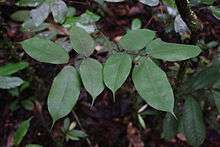Eperua
Eperua is a genus of flowering plants in the legume family, Fabaceae. It belongs to the subfamily Detarioideae. The fifteen species[1] belonging to this genus are distributed in the tropical zones of Africa and South America, living in the jungles, often along rivers or streams. The leaves are compound pinnate, with smooth margins, and the fruits are long pods. The wood of E. falcata is called wallaba and is often used in construction.
| Eperua | |
|---|---|
 | |
| Eperua falcata | |
| Scientific classification | |
| Kingdom: | |
| (unranked): | |
| (unranked): | |
| (unranked): | |
| Order: | |
| Family: | |
| Subfamily: | |
| Genus: | Eperua |
| Synonyms | |
| |
E. falcata Aubl. occurs in Suriname, French Guiana and Guyana, a 30 m high jungle tree called Wallaba or Bijlhout by the natives. The bark is grey brown, and the leaves pinnately compound with 2-4 pairs of obovate leaflets ~ 18 cm long. The flowers are bell-shaped in terminal or subterminal clusters. They have red petals, 5 fertile and 5 sterile stamens. The pods are up to 30 cm long and 6 cm wide, with 2-5 flat seeds.
E. rubiginosa also occurs in Suriname and Guyana; about 30 m high. It has unpaired pinnately compound leaves. The flowers with red and white petals have 10 fertile stamens. The pods are rusty brown, and up to 25 cm long and 5 cm wide.
E. schomburgkiana ~30 m high; occurs in the Guyanas. The flowers are in clusters and contain 10 fertile stamens. The pods are 20 cm long.
E. grandiflora : "Itoeri wallaba" also occurs in Suriname and the two Guyanas.
References
- "The Plant List: Eperua". Royal Botanic Gardens, Kew and Missouri Botanic Garden. Retrieved 14 Nov 2016.
| Wikimedia Commons has media related to Eperua. |